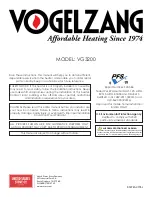
8
SR468SE 27-06-13
Inner firebox:
Brush the inside of the firebox clean from time to time to check the integrity of the plates
and liners etc. It is not normally necessary to re-paint inside the firebox due to the high temperatures that
mean that the paint does not have much effect before being burnt off. Steel and cast iron liners are resilient
firebox materials and will give reliable service without major cleaning or work on the firebox.
Baffle:
It is essential to check the top of the baffle for build-up of soot and ash regularly when in use and
after a long period of no use. From time to time remove the baffle if necessary to ensure that the flue way
entrance is clear. Take note of the baffle orientation when removing and ensure it is refitted the same way.
Fuels
Wood
Burn only seasoned timber products with a moisture content of less than 20%. To obtain this moisture
content allow cut wood to dry for at least 12-18 months.
Do not burn construction timber, treated or
painted wood, manufactured board or pallets.
Solid Fuel
Burn only manufactured smokeless fuels listed as suitable for use in a closed appliance.
Do not burn
bituminous coal, “petro-coke” or other petroleum based fuels as this will invalidate the warranty.
Please note that HETAS Ltd appliance approval only covers the use of wood logs on this appliance. HETAS
Ltd approval does not cover the use of other fuels either alone or mixed with the recommended fuels listed
above, nor does it cover instructions for the use of other fuels.
Notes on Wood burning
Notes on Wood burning
With a full load of wood, the stove will need to be refuelled approximately every 0.75 – 1.5 hours, (see table
on page 6 for refuel period for individual models).. Wood can be stacked higher in the stove than solid
mineral fuel but care must be taken that logs do not touch the baffle.
Wood burns most efficiently with the primary air controls closed and the secondary control partially open.
Moving the secondary control will control the burn rate of the stove.
Note – primary and secondary air is needed to light the stove, see section entitled
„Lighting the Stove‟.
Wood burns best on a bed of ash and it is therefore only necessary to remove surplus ash from the stove
occasionally.
Burn only dry, well-seasoned wood, which should have been cut, split and stacked for at least 12 months,
with free air movement around the sides of the stack to enable it to dry out. Burning wet or unseasoned
wood will create tar deposits in the stove and chimney and will not produce a satisfactory heat output. Do
not use liquid fuels in this appliance.
Lighting the Stove
We recommend that you have two or three small fires before you operate your stove to its maximum heat
output. This is to allow the paint to cure in steadily and to give a long service life of the paint finish. During
this curing in process you may notice an unpleasant smell whilst the finishes finally cure. It is non-toxic, but
for your comfort we would suggest that during this period you leave all doors and windows open.
First, open the primary and secondary air wash control fully. Load the firebox with plenty of starting fuel,
i.e. paper, dry sticks and/or firelighters. Light the fire at the base leaving the primary and secondary air
control fully open. Leave the door slightly ajar for 10 minutes to enhance initial starting and reduce smoke
emission – DO NOT leave the stove unattended if the door is left ajar. Allow the fuel to reach a steady glow
and build the fire up gradually by adding a few small sticks or well split logs at a time. Once you have a
good fire bed established across the grate, further fuel can be added step by step as required. Don‟t be
tempted to overload the fire bed with fuel all at once or close down the air controls too much until the fire is
well established for some time. Once the ignition period is well under way close the primary air and
gradually reduce the secondary air wash control opening to establish the burning intensity you require.
Refuelling


































